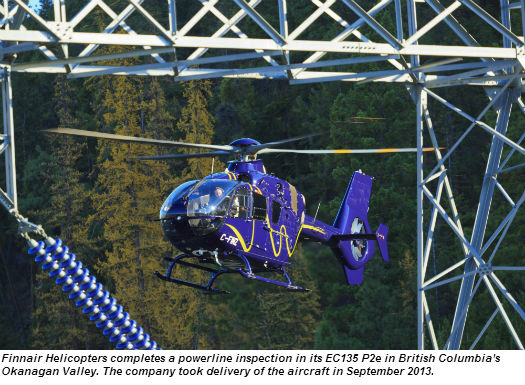
After a decade of flying helicopters on the Pacific coastline of British Columbia, Wayne Finn, together with his wife Joanne, moved to the beautiful Okanagan Valley in the province’s southern interior. Known as one of the warmest regions in Canada, the picturesque land that hugs the 135-kilometer-long Okanagan Lake is a favorite destination for outdoor enthusiasts, and its climate combined with its fertile soil has led to it becoming a prime agricultural area with a flourishing wine industry.
The Finns moved to the Okanagan with the intention of starting a helicopter company in the region. Today they own and operate Finnair Helicopters Ltd., servicing the utility sector in B.C.’s interior with a brand new Airbus Helicopters EC135 P2e. However, the step between the move to the Okanagan and the company as it stands today wasn’t quite as straightforward as it may seem.
Embodying the self-belief that courses through most entrepreneurs, the Finns took a step into the unknown when they first arrived in Naramata, on the eastern shore of the Okanagan Lake. After driving around several of the vineyards that are thickly spread throughout the region, the couple decided to take a detour from their plan — and buy a winery instead of establish a helicopter company. Wayne kept current with his piloting skills by taking the odd contract job flying in the summer, but, while the couple found winemaking an “interesting business to be in,” Wayne realized he was missing being in the cockpit full-time.
“I would be sitting there in the vineyard, pruning in the springtime, and a helicopter would fly over,” said Wayne. “I would just be staring up wondering what I was doing down here talking to a bunch of grapevines.”
After three years, an offer came in for the vineyard that was “too good to refuse,” and Wayne returned to helicopter operations as chief pilot and ops manager at Kokanee Helicopters in nearby Kelowna. Two years later, in 2007, the couple decided to strike out on their own again, and established Finnair.
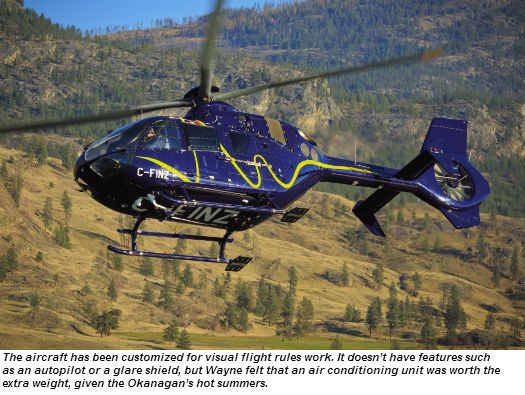
BREAKING NEW GROUND
Although Finnair wasn’t the first helicopter operation the couple had established (they were the founders of West Coast Helicopters in Port McNeill, B.C.), it was still a step into the relative unknown with a new model of operation — both in terms of personnel and aircraft. The roles remain much the same today as they did at the beginning — Wayne as the sole pilot and operations manager; Joanne overseeing the flight following, accounting, and administration. (Maintenance is contracted out to Vector Aerospace.) Setting a precedent that would continue with subsequent aircraft choices, they helped break new ground with the selection of an Airbus Helicopters EC120 to establish their operation.
“We were one of the first companies to start operating an EC120 commercially in B.C., and always sold the aircraft for the safety features it has,” said Wayne.
To begin with, the company was working across a range of operations with a variety of customers. “We were doing everything,” said Wayne, “anything a general charter company would do. But the bulk of our work was with BC Hydro [the provincial electric utility company].”
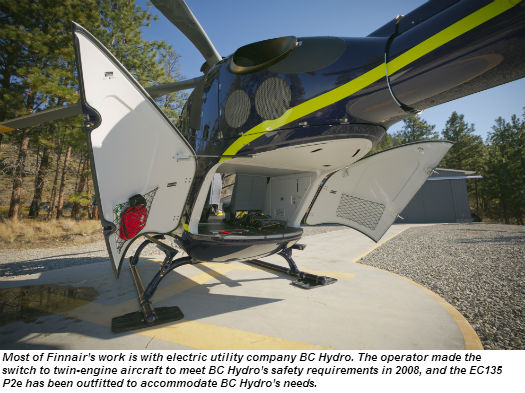
So fruitful was this partnership, that Finnair had a major decision to make when B.C. Hydro established a requirement for twin-engine helicopter operation in 2008, just a year into the operator’s existence. (The requirement was the result of a fatal accident in Cranbrook, B.C., when a Bell JetRanger hired by BC Hydro crashed after the engine lost power during a low-level line inspection flight, killing the pilot, two BC Hydro employees, and a pedestrian.)
With a brand new single-engine EC120, Finnair either had to give up all the operations it was flying with BC Hydro, and concentrate on fires and general charters — or find a new twin-engine aircraft to keep the utility company as its main customer. It was a big decision for a young (and small) company to make, but the Finns decided to make the jump into the twin-engine market, leasing a Bell 427 — again, one of the first in Western Canada — and selling the EC120. The aircraft was brought in on a two-year lease, and as it approached the end of its term, Finnair began looking for a longer-term replacement.
“Although the 427 met our safety standards, it wasn’t quite meeting our requirements for performance, and as a legacy aircraft, it was becoming a little bit harder to get product support,” said Wayne. After considering the Bell 429, Finnair eventually chose the EC135 P2e.
“We went to [the Airbus Helicopters site in] Donauwörth, Germany, saw the facility and liked what they were doing,” said Wayne, who subsequently completed his type training at the plant. Airbus Helicopters Canada did the completion of the aircraft for its utility role at its facility in Fort Erie, Ont., and it was delivered to Finnair in September 2013.
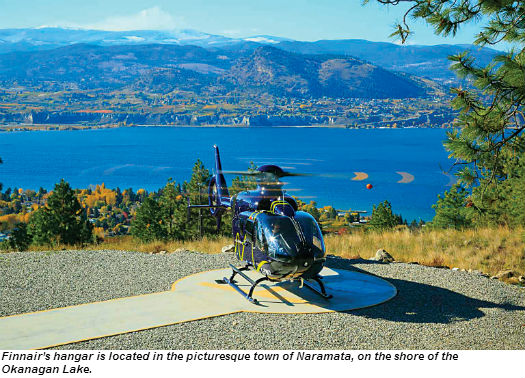
While most of the EC135s in operation around the world are designed for dual pilot, instrument flight rules (IFR) operation, Finnair’s aircraft is customized for the VFR work it performs. “We forewent a lot of the add-ons, such as the autopilot and a lot of the things that add the weight up on the aircraft — and subsequently add up the cost at the same time,” said Wayne. “What we wanted was something that we could put a hoist on in the future, and we wanted a dual cargo hook, because we’re hoping to start performing a lot more Class D [external human cargo] operations as a work method.”
Due to the heat of the Okanagan, air conditioning was also a must — to look after the comfort of the passengers as much as the pilot. For line patrols, the company is installing a Swesystem Explore 400 Triple camera (with a Meeker mount), that has the capability to record infrared and ultraviolet images, in addition to high-definition video. (At press time, Finnair expected to have the camera operational in June 2014.)
As a good proportion of Finnair’s work is completed with B.C. Hydro as part of a multi-year contract between the two, Wayne said it was important to take the utility company’s considerations into account when he was looking for a new aircraft.
“One of our things we’ve always done with BC Hydro is we’ve kind of worked from the ground up, listening to the guys that are actually in the field,” he said “They tell us what would make their life easier, and we’ve kind of adapted our aircraft to fit their needs.”

A GOOD RELATIONSHIP
In terms of the helicopter operations supporting BC Hydro, the province is divided into six regions — with Finnair performing the various line patrols, construction and maintenance work the utility company needs to complete in the region surrounding the Okanagan Valley.
Wayne said the line inspection flights average about five hours — which is BC Hydro’s limit for time on the line, or in the wire environment. Currently, they fly with two or three BC Hydro employees, but when the camera is in place, that will likely be reduced to two: a camera operator and a lineman. When long lining, the cabin seats are easily removed to allow the aircraft to be specifically configured for that role.
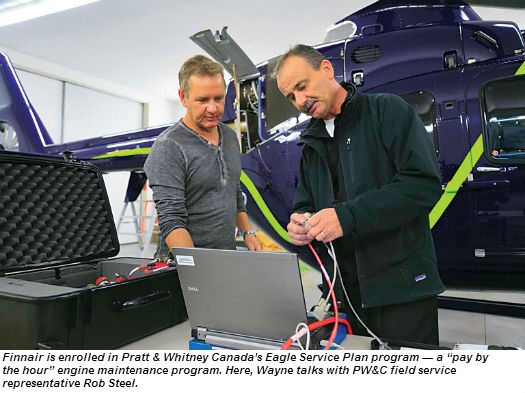
“BC Hydro has about 18,000 km [11,185 miles] of line in the province, and a lot of it is actually aging and the maintenance is quite high to keep everything working properly,” said Wayne. “With the camera, we’re trying to look at stuff a little bit differently — to be a little bit more proactive rather than reactive.”
Wayne said the precision long lining work is the most challenging. “You can get some nasty winds through the Okanagan, and of course we get very high temperatures here — so your density altitudes on a 35 to 40 C [95 to 104 F] day can really catch up to you if you’re not paying attention.”
He said crew resource management is important to ensure safety during long line patrol flights. “The wire environment is very unforgiving and we’re all very aware of that,” he said. “We’ve done a lot of modifications to the aircraft — such as making sure that everybody’s hearing all the radios at the same time — to help combat the potential pitfalls and dangers of that environment.”
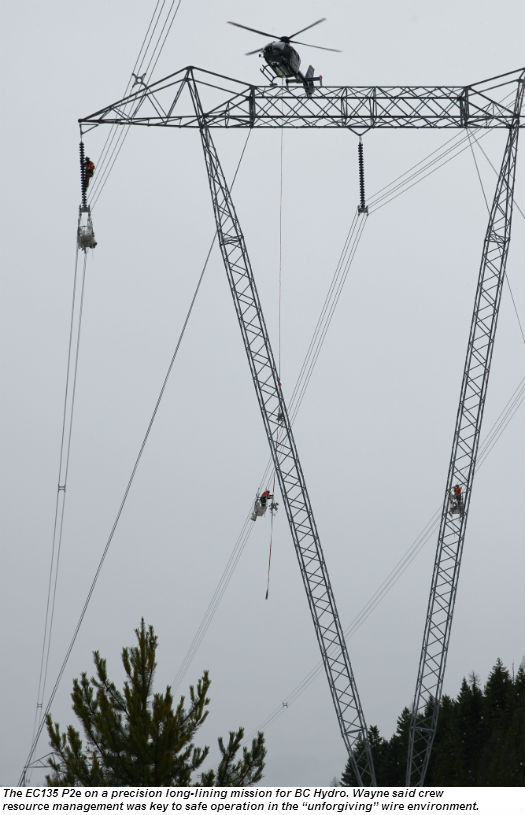
Beyond its work with BC Hydro, Finnair is still exploring various opportunities and working out the best applications for the EC135 — with modern twin-engine aircraft still something of a rarity in the general utility market. Wayne said they were aware they need to go after “specialized markets” due to the cost of the aircraft, but added that the company had “done away with some of the old myths of the helicopter business” in terms of the hourly rate needing to be one percent of the capital cost to make an operation profitable.
“We decided to try to keep the rates reasonable on the 135 by financing it over a longer timeframe,” he said. “It’s a six million dollar aircraft; if we went to our customer and said we want $6,000 an hour for it, we probably wouldn’t be doing a lot of work right now.”
But Wayne said the company’s focus on bringing the highest level of safety to utility operations sets it apart from its competitors. He said increasingly educated customers were showing this effort to be worthwhile.
“I think we’ve raised the standard quite a bit as far as helicopter safety goes,” he said. “We educate the crews we work with on the safety features of our aircraft, such as crashworthy seats and crashworthy fuel systems — much to the dismay of some other people, because if our crews are then offered a helicopter without these safety features, they will think twice about getting in it.”
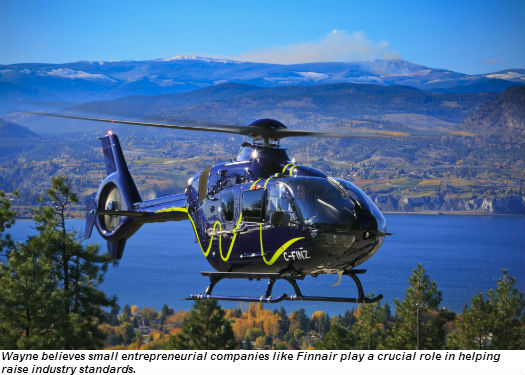
CONTINUING A FOCUSED SERVICE
While financing is clearly a large challenge for any small operator, Wayne said the biggest obstacle Finnair has to overcome is sometimes just its size.
“It’s a blessing, but it can be a curse,” he said. “People look at you and say you’re just a tiny operator, and they think they should be flying with the HNZs or CHCs of the world, because they think they can provide better service. . . . But I believe it’s the smaller entrepreneurial guys that will drive this industry forward. They’re the people that embrace change and try to push a higher standard for the industry.”
Looking ahead, Wayne said he hoped Finnair would largely stay the same size, although the company is looking at hiring another pilot to allow for dual pilot operations for certain projects — and to give him the odd day off to spend more time with his family.
He said working as a mom-and-pop team had been central to Finnair’s success, describing his wife Joanne as his “greatest asset and partner,” in doing much of the company’s work behind the scenes.
“If you believe in yourself, and you invest in yourself, we’ve always found that that’s a way surer bet than investing money in the stock market or anything like that,” said Wayne. “It definitely has its highlights and lowlights, but there’s only one go-around in life, and we’re very much enjoying what we’re doing.”





